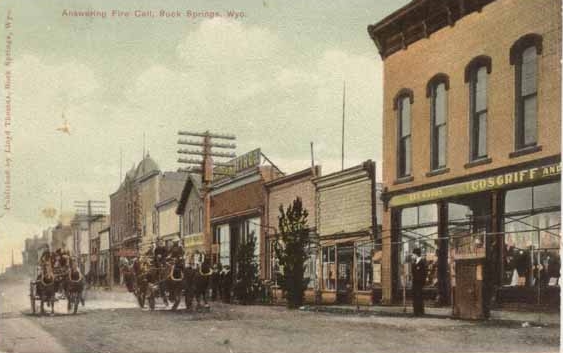
Fire Brigade, Rock Springs, Approx. 1900
The above scene is directly in front of the Union Pacific Depot on South Main, see picture lower on page. Note false fronts on the second, third and fourth
buildings from the right. The fourth building, with the sign braced on the
top of facade, is
J.P. McDermott Co. Past the building with the gable is the Pacific Market.
Rock Springs originally was merely a way station on Ben Holladay's Overland Stage Line
after the line was moved south in 1862 to avoid Indians. As a town it
received its start in 1868 when the Railroad arrived.
The town was described in a letter dated 1876 written by Mabel Hubbard to her future husband Alexander Graham Bell:
We are stopping now at a coal station, and have come upon the first signs of life
except the miserable little house that adjoins the wood stations. There are
coal mines around, on the hills on my left I see smoke rising out from the hills,
it is a mine or fire, nearer us smoke rises from some tall chimneys of
manufacturing buildings, we have come to the first busy looking place
for many a long mile but the houses are all of the poorest description
and look temporary. There is no appearance of home about them as there
was in even cold and dreary Lamarie. There the land is cultivable and
settlers have made homes there, here the fetid water's make mans stay here
one of necessity never of choice.
O how I wish you were here you would enjoy it all so much, the wild
scene -- not the living!!. Our party is reduced to it's usual size
again except for the presence of Dr. -- Superintendent of Mints of the
United States.
When you write to your Mother please give her my love and tell her I
want to write to her but cannot do so very well in the cars.
The houses of the miners are built in an abrupt ravine, the walls
of which form one of the sides of their houses. The roofs and sometimes
a window project above the surface of the ground -- the roofs are covered
with dried earth and clay, and the whole settlement has such a queer
appearance. Just now a "heaten Chinee" passed us trudging laboriously
along with a big piece of raw meat at one end of a long branch he carries
over his shoulder and a heavy sack on the other end. We have come to the
region of chinamen. The valley around us is so queer flat with sudden
fissures running through it. The ground is covered with bunches of the
sagebush. Just now a pure white mountain rises up over the rock hills
around us, sharp and white against the blue sky recalling the Jung'frau
in it's shape and sharp stern purity. Rock Creek is the name of the mining
station we have left, hills near us grow more and more peculiar in their
formation at their base are rounded pillar-like protuberances.
[Webmaster's note:
It appears likely that Miss Hubbard miswrote. The letter was written in a
palace car on the Union Pacific heading west between Bitter Creek and Salt Lake. The letter indicated that
the quoted portion was written before reaching Green River. Rock Creek is in Albany County some
distance east of Bitter Creek in Sweetwater County. Additionally, the railroad
did not reach Rock Creek until 1878, two years following the letter.]
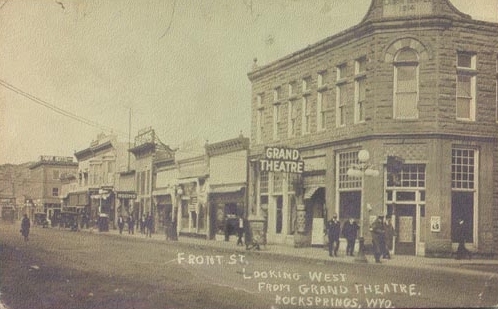
North Front Street, 1915
The building on the corner is the Labor Temple and bears the date
1914 on the pediment.
As indicated by the next scenes below depicting the welcoming arch
on the Lincoln Highway as it enters town from either end, coal has been
important since the arrival of the railroad. Coal mining began in the territory on a
small, non-commercial scale about 1860. The first large scale commercial mines opened
in 1868 in Carbon, now a ghost town, about 14 miles west of Medicine Bow. At
one time Carbon had a population of about 3,000 residents, a state bank, newspaper and
seven active mines. The Town's fate was sealed, first by a fire in 1890 which
was stopped only by dynamiting buildings and secondly, by the relocation of the railroad
through Hanna in 1899. The relocation was prompted by the finding of a route
which avoided the six-mile grade at Simpson Hill and the necessity of double-heading
the locomotives. By 1902 Carbon was abandoned and nothing remains except
the cemetary and a few sandstone foundations.
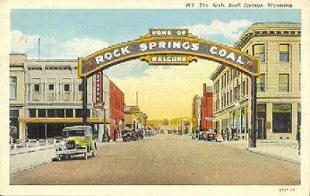 Arch, approx. 1928
Arch, approx. 1928 |
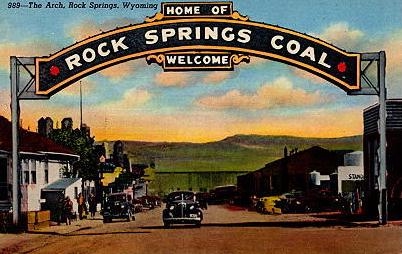
Arch, approx. 1938 |
With the mines also came labor strife. In 1875, the English ("Lankies") and
Swedish miners went on strike. The railroad brought in Chinese miners to break
the strike. Resentment as a result and in addition to the willingness of the
Chinese to work for less continued until it boiled over
on September 2, 1885, when word was received that Colorado
miners were receiving a pay raise but the ones in Rock Springs were not.
The Lankies and the Swedish miners, most of whom were members of the
militant Knights of Labor under the leadership of Terence Powderly (1849-1924)
rose up, burned the homes of approximately 75 Chinese families, 28 Chinese
were killed and 15 wounded. The Chinese fled toward Green River and were rescued by the Union Pacific.
Federal troops were brought in to restore order and remained in Rock Springs
until 1898. Although the Knights of Labor supported the Chinese Exclusion Act, the
United Mine Workers took a different attitude and by 1908, Chinese were
attending UMWA meetings in Rock Springs. Rock Springs, however, was
not the only mining town in the west in which Chinese miners were forcibly
ejected from their homes and work. In January 1886, in Maiden, Montana,
masked, armed miners "escorted" Chinese out of town, allowing them to send
the next day for their belongings. The [Maiden] Mineral Argus congratulated its
readers on the peaceful manner in which the Chinese were excluded.
 Wyoming General Hospital (the "Miners' Hospital"), Rock Springs, 1908
Upon admission to the Union on July 10, 1890,
the State received, among others, a 30,000 acre land grant to be used for the
construction and operations of the Miners' Hospital. In the 1892 election
Rock Springs was designated as the location. The cornerstone was laid on December
2, 1893, by members of Rock Springs Lodge Lodge No. 12, A.F. & A.M.
History of Masonry and other fraternal orders is discussed in
Cheyenne III as a part of text relating to fraternal lodges in
Cheyenne.
In 1901 the one-story nurses' dormitory was added. Two story additions were added
to the main structure in 1932 and 1940. The Hospital was transferred to Sweetwater
County in 1948. The Hospital now known as Memorial Hospital was moved to
its current location on College Drive in 1973.
Wyoming General Hospital (the "Miners' Hospital"), Rock Springs, 1908
Upon admission to the Union on July 10, 1890,
the State received, among others, a 30,000 acre land grant to be used for the
construction and operations of the Miners' Hospital. In the 1892 election
Rock Springs was designated as the location. The cornerstone was laid on December
2, 1893, by members of Rock Springs Lodge Lodge No. 12, A.F. & A.M.
History of Masonry and other fraternal orders is discussed in
Cheyenne III as a part of text relating to fraternal lodges in
Cheyenne.
In 1901 the one-story nurses' dormitory was added. Two story additions were added
to the main structure in 1932 and 1940. The Hospital was transferred to Sweetwater
County in 1948. The Hospital now known as Memorial Hospital was moved to
its current location on College Drive in 1973.
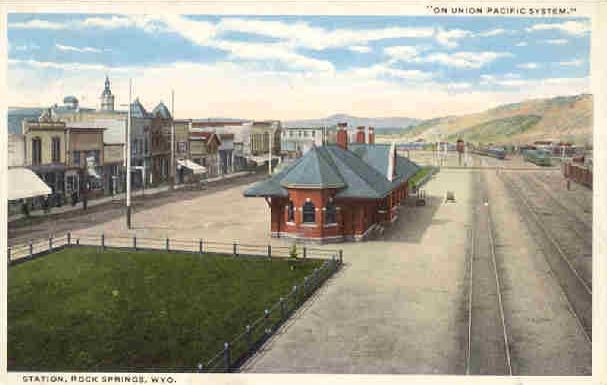
Rock Springs Depot, 1922
Compare above scene with earlier view above. The spire is the 1894 City Hall now housing
the Rock Springs Museum.
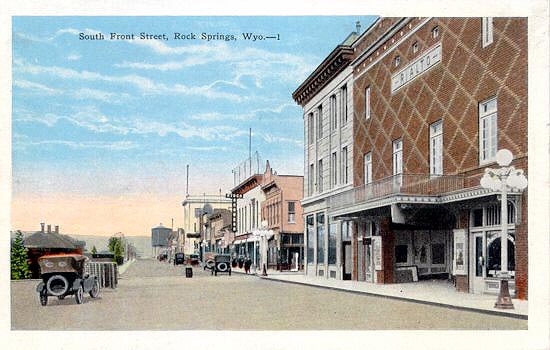
South Front Street, 1920's
In the 1920's Rock Springs even though it had a population
of over 9,000, paved streets, street lights, and a movie palace, did not leave much of an impression on some visitors. James Montgomery
Flagg, described his honeymoon stay:
Freight engines screamed and tooted around the little hotel at Rock Springs all night long,
as if warning the guests not to come out onto the tracks in their pyjamas.
I found out why Maclyn Arbuckle said, after a night in one of this town's
few hostelries, that he had discovered why it was called Rock Springs!
Webmaster's note: My bride's remembrance of Rock Springs is her
first trip to Wyoming, a rather "bumpy" ride, coming into Rock Springs on the "Vomit Comet."
|